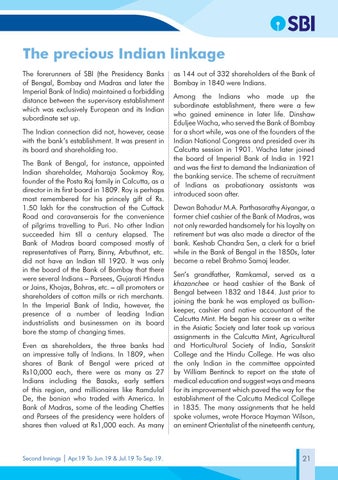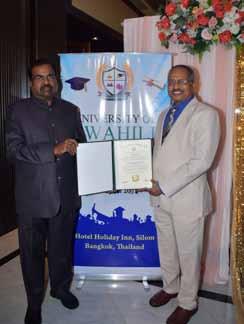The precious Indian linkage The forerunners of SBI (the Presidency Banks of Bengal, Bombay and Madras and later the Imperial Bank of India) maintained a forbidding distance between the supervisory establishment which was exclusively European and its Indian subordinate set up. The Indian connection did not, however, cease with the bank’s establishment. It was present in its board and shareholding too. The Bank of Bengal, for instance, appointed Indian shareholder, Maharaja Sookmoy Roy, founder of the Posta Raj family in Calcutta, as a director in its first board in 1809. Roy is perhaps most remembered for his princely gift of Rs. 1.50 lakh for the construction of the Cuttack Road and caravanserais for the convenience of pilgrims travelling to Puri. No other Indian succeeded him till a century elapsed. The Bank of Madras board composed mostly of representatives of Parry, Binny, Arbuthnot, etc. did not have an Indian till 1920. It was only in the board of the Bank of Bombay that there were several Indians – Parsees, Gujarati Hindus or Jains, Khojas, Bohras, etc. – all promoters or shareholders of cotton mills or rich merchants. In the Imperial Bank of India, however, the presence of a number of leading Indian industrialists and businessmen on its board bore the stamp of changing times. Even as shareholders, the three banks had an impressive tally of Indians. In 1809, when shares of Bank of Bengal were priced at Rs10,000 each, there were as many as 27 Indians including the Basaks, early settlers of this region, and millionaires like Ramdulal De, the banian who traded with America. In Bank of Madras, some of the leading Chetties and Parsees of the presidency were holders of shares then valued at Rs1,000 each. As many
Second Innings | Apr.19 To Jun.19 & Jul.19 To Sep.19.
as 144 out of 332 shareholders of the Bank of Bombay in 1840 were Indians. Among the Indians who made up the subordinate establishment, there were a few who gained eminence in later life. Dinshaw Eduljee Wacha, who served the Bank of Bombay for a short while, was one of the founders of the Indian National Congress and presided over its Calcutta session in 1901. Wacha later joined the board of Imperial Bank of India in 1921 and was the first to demand the Indianization of the banking service. The scheme of recruitment of Indians as probationary assistants was introduced soon after. Dewan Bahadur M.A. Parthasarathy Aiyangar, a former chief cashier of the Bank of Madras, was not only rewarded handsomely for his loyalty on retirement but was also made a director of the bank. Keshab Chandra Sen, a clerk for a brief while in the Bank of Bengal in the 1850s, later became a rebel Brahmo Samaj leader. Sen’s grandfather, Ramkamal, served as a khazanchee or head cashier of the Bank of Bengal between 1832 and 1844. Just prior to joining the bank he was employed as bullionkeeper, cashier and native accountant of the Calcutta Mint. He began his career as a writer in the Asiatic Society and later took up various assignments in the Calcutta Mint, Agricultural and Horticultural Society of India, Sanskrit College and the Hindu College. He was also the only Indian in the committee appointed by William Bentinck to report on the state of medical education and suggest ways and means for its improvement which paved the way for the establishment of the Calcutta Medical College in 1835. The many assignments that he held spoke volumes, wrote Horace Hayman Wilson, an eminent Orientalist of the nineteenth century,
21












